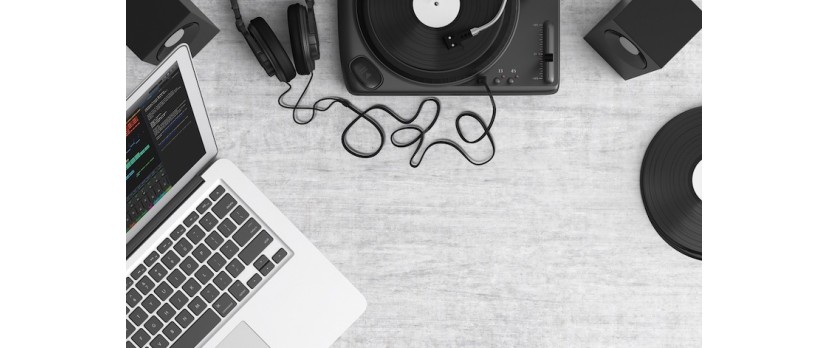You've probably seen AI-driven visuals sweeping across websites like wildfire. But you can take one step further and incorporate smart audio elements as well. This move can set you apart from competitors who rely solely on visual appeal.
The best news is that, due to tools becoming more accessible and affordable than ever before, now is the perfect time to consider embracing this dynamic feature.
If you’re still figuring things out, we put together a list of creative approaches you can use to implement audio on your eCommerce site to captivate audiences and boost engagement effortlessly.
1. Immersive Product Demos
Authentic sounds add a layer of authenticity to your product demos. Imagine showcasing a blender with the satisfying whirl of its motor. Customers get an instant feel for its power and noise level. Or consider a guitar store featuring the strum of strings to highlight tonal quality.
To test out the impact of sound effects, start small. Test simple effects like clicking sounds when adding items to carts or subtle ambient noise that reflects product use scenarios. The good news is that you don’t have to invest much in this project - you can use a platform for AI sound effects to get things started.
Audio provides depth beyond visuals, capturing attention through another sensory channel while creating memorable shopping moments that encourage purchasing decisions. This approach connects on an emotional level and builds loyalty over time.
2. A Personalized Experience with Audio Guides
With personalized audio guides, friendly shop assistants can guide customers’ journeys, answer questions, and offer advice. Imagine visiting an eCommerce site where you can opt to have a soft voice offer tailored product recommendations based on browsing history or preferences.
How can you implement this? Start by using AI tools that analyze customer data to create unique audio scripts for each visitor category. Pair these scripts with an AI voice generator to create synthetic voices that reflect your brand’s tone (like warm and inviting or bold and adventurous).
Companies like Amazon already experiment with personalized voice technology in smart speakers, making it easier for smaller retailers to adopt a similar approach. Plus, by incorporating personalized audio cues directly on websites or apps, you can tap into the growing trend of hands-free interaction.
3. The Psychology of Background Music in Shopping
The psychology of background music in shopping is a fascinating area with proven impacts on consumer behavior. A recent study shows that slow-tempo music encourages shoppers to linger, leading to higher spending.
This is why most supermarkets and other brick-and-mortar stores play calm tunes that enhance focus and relaxation.
To make things a bit more personal, you could choose tracks aligned with your brand image. For instance, soothing classical pieces or ambient sounds work well with luxury brands, while upbeat rhythms are amazing with sports apparel buyers.
Incorporating music not only sets the mood but also subtly influences decision-making processes. Some businesses find success adjusting playlists seasonally (yes, Christmas music is there for a reason!) or during promotional events to reflect changing themes.
4. AI-Driven Voice Assistants
We know you’re always looking for strategies to boost user engagement, and implementing AI-driven voice assistants might just be the next big thing. The right AI voice assistant can elevate the online shopping experience and make it feel more like an in-store interaction.
AI solutions like Google's Dialog Flow or Amazon's Alexa Skills Kit can help you create custom voice interfaces for your platform. These tools simplify development processes and offer robust functionality tailored to online retail needs.
For instance, many businesses use AI chatbots that respond to vocal prompts for FAQ assistance or order tracking updates. This convenience enhances the user experience while minimizing friction points often encountered with traditional text-based interfaces.
One area where audio enhances the customer experience is through the music available on various platforms. Integrating sound isn't exclusive to eCommerce but also vital for musicians aiming to promote their work online. Just as voice assistants make shopping more interactive, businesses in other sectors thrive by offering easily accessible platforms for creative sharing. Helping independent artists release their music online is a way DistroKid assists musicians to get noticed on major platforms like Spotify and Apple Music.
5. Sound Branding: Crafting an Audible Identity
Sound branding is similar to regular branding strategies, but you use sound instead of visuals or text. The idea is to create an audible identity that sticks with customers long after they've left your site.
Think of a recognizable jingle or a signature sound that’s been stuck in your brain for years. Do you know the iconic Intel chime or Netflix's "ta-dum"? Sounds like these leave a lasting impression and awaken a wide range of emotions when heard.
To create your brand’s sound, start by defining audio elements that reflect your brand’s personality. Is it playful? Seriously? Think about it. Also, you should work with a sound designer to craft a unique auditory signature tailored specifically for you.
You should also observe how big brands consistently leverage these cues across marketing channels, from website interactions to social media and advertising spots. Overall, playing with strategic soundscapes is a great way to strengthen overall brand recognition without overwhelming your budget.
Wrap Up
Implementing audio features begins with assessing your current platform's capabilities. Research available AI tools and sound libraries that fit your brand's needs. Start small by testing specific elements like personalized guides or background music. Gather feedback, refine strategies, and gradually expand to create a dynamic auditory experience for customers.


Login and write down your comment.
Login my OpenCart Account